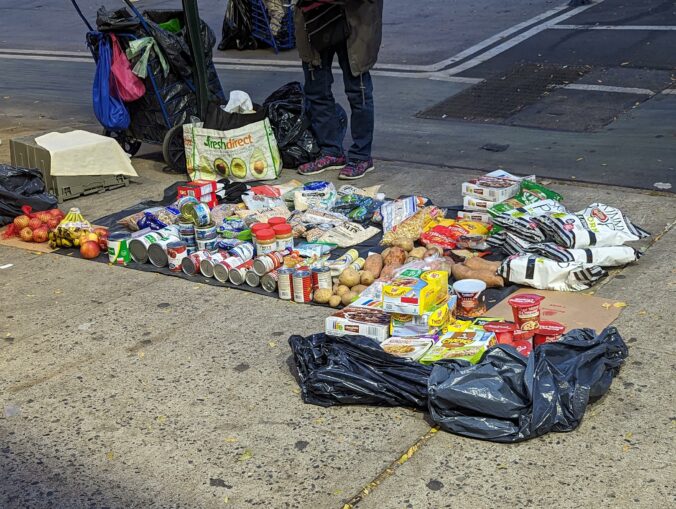The New York Times exaggerates

Food being sold on New York City’s Lower East Side.
New York City
We were shocked when we read a full-page article in the July 10 New York Times with the headline “Mean Street in New York Is a Haven For Mayhem.”
For over 30 years, we have lived just a few minutes walk from the block the Times is calling a “mean street.”
We’ve shopped on it from Mustafa’s fruit and vegetable truck for years, and we certainly shop at Trader Joe’s. Occasionally we get a potato, some ground coffee or rice from the women who sell pantry goods at bargain prices from a blanket on the sidewalk.
Workers who need a bargain to feed their families buy food from the blankets.
And of course, there are people selling clothes and miscellaneous kitchenware and alcohol and illegal substances.
The article in The Times ignores the people selling bargain-priced food to concentrate on those selling illegal substances.
It doesn’t mention the fact that the Sanitation Department has fewer trash cans on this block than are needed and doesn’t empty the ones it does have often enough.
We don’t feel threatened by the drug dealers, who generally ignore people who aren’t their customers.
The “mayhem” the Times refers to is a stabbing death on this block that occurred in late June.
Such a fatal event is uncommon. The New York Police Department’s 9th Precinct, which includes the East Village, has recorded no other homicides so far this year, as shown by the NYPD’s own data.. Last year by this point, there had been one homicide in the precinct.
The City of New York, under a lot of pressure from real estate interests to support the gentrification of the neighborhood around Avenue A and 14th Street, has said it will spend $1 million on a mobile police control post and high intensity night lights.
But what the city administration should do instead of increasing police control is to provide housing for the homeless, as well as distribute food stamps and improve access to food pantries, jobs and medical and mental health services.
Real estate context
Stuyvesant Town/Peter Cooper Village (STVPC) was financed by the Metropolitan Life Insurance Company (later renamed MetLife) in the 1940s when there was a housing crisis and many returning World War II veterans sought affordable housing.
The company had substantial financial help from the New York City government. The housing development’s southern boundary is 14th Street. It currently has about 30,000 residents.
In order to create this huge middle income project in the 1940s, Metropolitan Life, with essential New York City assistance, destroyed a neighborhood of manufacturing and commercial businesses and substandard cold water flats housing 12,000 people. That’s 3,000 families. Hundreds of small businesses were also impacted.
MetLife sold it for $5.4 billion in 2006 to Tishman Speyer and BlackRock, making about $3 billion profit on the deal. The purchasers estimated the property was worth $6.3 billion. After the Wall Street collapse in 2008, STVPC was valued at $1.9 billion. (For details, see the book, “Other People’s Money,” by Charles Bagli.
Unless the block between First Avenue and Avenue A is gentrified, the luxury apartments proposed for the neighborhood and the gentrification of STVPC will be impossible.

